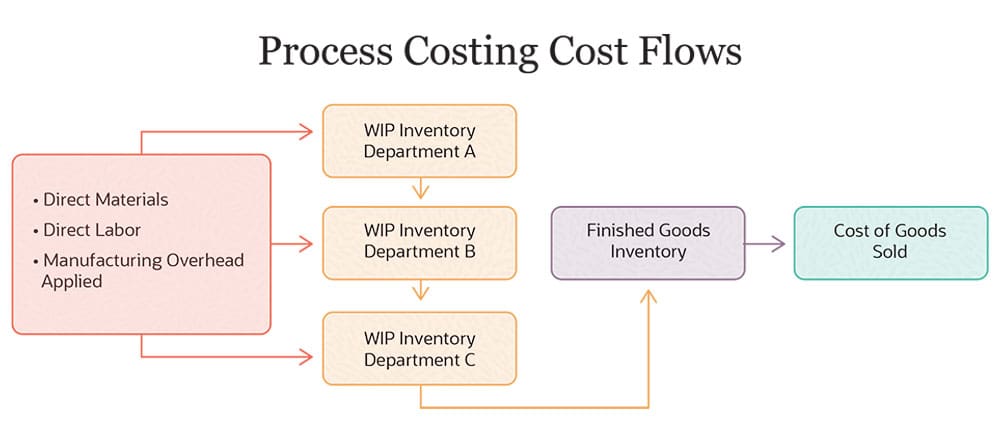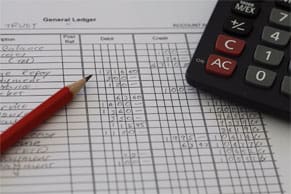Process costing is an accounting method typically used by companies that mass produce very similar or identical products or units of output. It’s common in manufacturing industries where the costs of producing each unit of output are very similar, and it doesn’t make sense to try to track costs for each individual unit throughout the production process. For example, process costing is used by oil companies that produce millions of gallons of fuel and by processed food companies that make millions of identical packages of snacks.
What Is Process Costing?
With process costing, companies determine item cost by tracking the cost of each stage in the production process, instead of tracking costs for each individual item. After adding up the cost of all the steps in the process, they divide the total cost by the number of items. This is called the cost per unit. For example, a paper company might track the cost of each stage in the process of turning wood pulp into reams of paper, then divide the total cost by the number of reams to get the cost per ream.
Key Takeaways
- Process costing is an important product costing method for manufacturing companies that mass produce a large volume of similar products or units of output.
- Process costing is widely used in industries such as oil refining, food production, chemical processing, textiles, glass, cement and paint manufacture.
- When using process costing, companies determine item cost by tracking the cost of each stage in the production process, then divide the total cost by the number of items produced.
- Companies can calculate costs using several different methods, including weighted average costing, standard costing and first in, first out (FIFO) costing.
Process Costing Explained
Homogeneous items are products that cannot be distinguished from one another — for example, a bin of screws of the same size and type. These similar products all generally flow through a number of stages during the production process. To use the process costing approach to accounting, companies determine the direct costs and manufacturing overhead for each of those stages.
These stages include direct and indirect costs. Direct costs are those directly incurred for production, such as raw materials and machine operators’ wages. Overhead often includes indirect costs such as equipment maintenance and facility rent, as well as the wages of administrative staff who aren’t directly involved in making the products.
Companies often break down these costs into direct materials and conversion costs. Direct materials are the materials consumed at each stage; conversion costs are process-related costs such as payroll and manufacturing overhead.
At many companies, a different department handles each stage in the production process. Each department prepares a report that details its direct materials, direct labor and manufacturing overhead costs. The company then aggregates these reports to analyze total product cost.
Process vs. Job Costing
Two of the primary methods of determining the cost of each product are process costing and job costing. Process costing doesn’t rely on tracing the costs of each individual item throughout the production process, so it’s particularly useful for industries that mass produce identical items and cannot easily trace each item’s costs. Job costing, in contrast, tracks all direct and indirect costs for each item or project. This is more commonly used by companies that offer custom products or services and price each one individually. For example, a construction company that makes custom homes needs to know exactly how much it costs to build each house so it can charge an appropriate amount and track whether each home-building project is profitable.
Importance of Process Costing
Process costing is particularly important in the oil, chemical, lumber, textile and food processing industries. Getting a handle on production costs enables these companies to set the right prices for their products and determine whether costs are tracking in line with projections. They can use process costing to analyze the costs of each step of the production and distribution process and use the information to identify areas where they can reduce costs.
Why Use Process Costing?
Process costing is the logical choice for keeping tabs on product costs in industries where the individual units of output are uniform and individually not worth a great deal — such as reams of paper or bottles of soda — and where it’s impossible or difficult to trace production costs for each individual unit. Instead, the cost of goods manufactured (COGM) is produced using process costing. This usually appears on your income statement.
-
Monitor profit margins: For industries that sell in high volume and operate with narrow profit margins, even a slight change in process costs can make a big difference to a company’s profit. Process costing enables companies to home in on the cost of each production stage and target specific departments for improvement.
-
Inventory control: Depending on the type of business, you may be required to report inventory to the IRS for tax purposes. For large companies producing thousands or even millions of products, this can be a difficult task. However, process costing can help simplify it. Each item produced is valued and each department tracks things like materials purchased.
-
Uniformity in reporting: With process costing, each department will track their own costs and all those will be rolled up to arrive at an overall cost to produce a specific number of items. Because all expenses have to be added together, they all need to be reported in the same manner and with the same cost codes. This helps bring uniformity to reports and makes it easier to track costs over time.
Using the Process Costing Method
Process costing involves tracking the number of units passing through the production process during a given period, collecting cost information for each stage and then using the collected information to calculate per-unit cost. Having accurate per-unit-costing helps with pricing products appropriately, which can lead to improved revenue and better profit margins.
5 Steps in Process Costing
To accurately estimate the cost of producing each unit, process costing takes into account work in progress — items that have entered but not completed the production process — at the start and end of each period. Here are five primary steps in process costing.
-
Analyze inventory: Analyze the flow of items during the period to determine the amount of inventory at the beginning of the period, how many items were started during the period, how many were completed and transferred out and how many were incomplete at the end of the period.
-
Calculate equivalent units: Process costing uses the concept of equivalent units to account for items that are unfinished at the end of each period. For this step, multiply the number of incomplete units at the end of the period by a percentage representing their progress through the production process. For example, if there are 2,000 units of inventory still in progress and they’re 75% complete, they are equivalent to 1,500 units for process costing purposes (2,000 x .75 = 1,500).
-
Calculate applicable costs: Total the costs for all production stages, including both direct materials and conversion costs.
-
Calculate cost per unit: Divide the total cost by the number of units. This calculation includes both completed units and equivalent units. So, if a business completed 4,000 products and another 1,000 units got halfway through production, the applicable costs would be divided by 4,000 + (1,000/2) = 4,500 units. If all the costs added up across all departments to produce those units was $16,875, simply divide the cost by the number of units to arrive at $3.75 per unit produced.
-
Allocate costs to complete and incomplete products: Allocate costs for the completed and ending work-in-progress inventory to the corresponding accounts. This helps determine how much money is tied up in current work-in-progress inventory. In the above example, since the equivalent of 500 units are in progress and it cost $3.75 to produce each unit, the work-in-progress inventory cost is $1,875 (500 x $3.75). And the complete product inventory cost is 4,000 x $3.75 = $15,000.
Types of Process Costing
In process costing there are three different ways to calculate costs: weighted average, standard costing and first-in first-out (FIFO). Carefully selecting the method that best meets your business needs is a best accounting practice.
-
Weighted average costs: This is the simplest method of calculating cost. Companies add all costs for the current period and divide by the total number of units completed and transferred out, plus the equivalent units of work-in-progress at the end of the period. It’s used for cases where cost fluctuations from period to period are minor.
-
Standard costs: This method uses an estimated standard cost for each process stage instead of actual costs. Companies typically use this method when it’s too difficult or time-consuming to collect current information about the real costs. It can also be beneficial for businesses that make a wide range of items and find it challenging to attribute precise costs to each of the products. The estimated totals are compared to actual totals after a production run is finished, and the difference is added to a variance account.
-
First in, first out (FIFO): The most complicated process costing approach, FIFO is used to obtain more precise product costing, especially in situations where costs change significantly from one period to the next. FIFO assumes that the first units in (i.e., work in progress at the beginning of the current period) are the first to be completed. When calculating costs for the current period, it excludes costs incurred during the previous period for those beginning work-in-progress units.
Examples of Process Cost Accounting
Process cost accounting is used in circumstances where the units of product are homogenous. Take a look at a few examples of how it works in these fictional companies. (The companies are not real.)
-
Bubblez’n’More is a seltzer bottling company specializing in unique flavors. The sodas pass through several production departments. During the current month, the filling department accumulates $25,000 of direct material costs and $50,000 of conversion costs (consisting of direct labor and factory overhead). For that period, the department processes 50,000 bottles. The per unit cost for the filling department in April is $.50 for direct materials (direct material costs divided by unit output for the month) and $1.00 for conversion costs (conversion costs divided by unit output). The company performs similar calculations for the labelling and packaging departments and finds that overall it spent $100,000 to produce 50,000 bottles in one month. The unit price = $100,000/50,000 = $2 per unit.
-
Reams-a-Plenty makes paper products from wood pulp. Raw materials move through the production cycle in a continuous flow, ending with the production of identical packages of paper. This month, it completes 150,000 packages. Raw materials total $50,000, or $.33 per package. Conversion costs are $100,000, or $.67 per package, comprising $70,000 in direct labor and $30,000 for overhead, including maintenance expenses, insurance costs and electricity. The total cost is $150,000, and with 150,000 units produced, its cost-per-unit is $1.
Pros and Cons of Process Costing
For certain types of manufacturers, process costing is the most practical and efficient accounting method for determining product costs. Still, this method has both advantages and disadvantages. It can be difficult to accurately assign costs to work in progress, for example. Consider the following pros and cons.
Pros of process costing:
Process costing can be easier to use than other costing methods, and it can help companies zero in on areas for potential cost cutting.
- Ease of use: For companies making many similar goods, process costing is more practical and simpler to use than other cost accounting methods, such as job costing, which involves tracking the cost of each item and component part, along with managing payroll, other materials and overhead.
- Flexibility: Process costing can help companies improve their operations to reduce costs, so they can offer products at more competitive prices. It highlights the cost of each step in the manufacturing process, helping companies target redundant, outdated or inefficient processes.
- Standardized: Process costing applies the same standardized costing method each period, enabling companies to compare changes in costs over time. This helps companies ensure that costs are in line with budgeted expenses and identify areas for investigation.
Cons of process costing:
Potential disadvantages of process costing include inaccuracy.
- Errors: Process costing determines the cost of each unit based on the overall costs of departments or stages involved in manufacturing. Errors can be caused by including non-production costs in the calculation.
- Calculation difficulties (equivalent units): Process costing also relies on calculations of equivalent units, which are determined by assigning costs to unfinished goods at the start or end of an accounting period. Companies include the value of this work in process on balance sheets. The real cost of these unfinished goods can vary, for example if the price of raw materials fluctuates from month to month. If companies don’t accurately estimate the cost of work-in-progress items, they’ll end up with inaccurate product costs.
- Time consuming: Calculating equivalent units can be time consuming. Management accountants have to determine how far down the line in the production process these unfinished goods are and assign costs accordingly.
Cost Flow in Process Costing
With process costing, companies track the flow of costs from department to department, rather than tracking costs for each individual item. Each department adds direct labor and manufacturing overhead costs, plus the cost of any raw materials it uses. Companies may use separate work-in-process inventory accounts for each department or stage in the process.

Manage Process Costing With NetSuite
Process costing assigns expenses to different departments in your business, and it accounts for various cost areas including materials and payroll. Those costs are then rolled up to determine an overall dollar figure and used to find the price-per-unit. All departments must use uniform reporting and not double count efforts. Enterprise resource planning (ERP) software can help with this process. It brings data from various business software modules from around your company — such as supply chain management, financial management and payroll management — into one digital space. By storing data from disparate areas of your company in one digital ecosystem, you can more easily track data and costs from throughout the manufacturing process and keep tabs on expenses and profitability. ERP platforms with integrated financial management software also help you more expertly, easily and accurately perform process costing. By working together with the same information across the business, costs can easily be tracked by department and roll up into macro-level process costing reports.
NetSuite’s ERP suite helps manufacturers manage every aspect of their business, from supply chain management and procurement to order fulfillment and customer relationship management (CRM). The fully integrated financial management solution helps businesses accelerate their financial close, provides strong expense management and real-time visibility into the company’s financial performance. And it can help you more expertly, easily and accurately perform process costing. By working together with the same information across the business, costs can easily be tracked by department and roll up into macro-level process costing reports.
Conclusion
Process costing is an important accounting method for manufacturers that make large volumes of identical items, such as companies in the food processing, oil and chemicals industries. For these companies, it can be difficult or impossible to directly allocate costs to each item as it moves through the manufacturing process. Process costing enables companies to estimate item costs by adding up the expenses of each step in the manufacturing process, then dividing by the number of items. To ensure accuracy, companies need to include only product-related costs from each department involved in the process and correctly allocate cost to work-in-progress at each stage. Financial management software, particularly platforms integrated into a larger ERP tool, can help track costs by department, as well as generate overview reports and store historical data to monitor trends over time.
#1 Cloud
Accounting Software
Process Costing FAQs
What is an example of process costing?
Using process costing, a seltzer bottling company would assign costs to each stage in the bottling process. It then totals the costs from each stage over an accounting period, dividing the overall process cost by the number of finished bottles to obtain a cost per bottle.
What are the steps in process costing?
There are five basic steps in process costing:
- Determine the number of completed items plus unfinished items produced during each period.
- Translate the work-in-progress items into equivalent units of finished goods by multiplying the number of unfinished items by their percentage of completion.
- Total the direct materials and conversion costs for each stage in the process.
- Divide the total cost by the number of units to obtain the cost per unit.
- Designate costs for complete and incomplete products.
What are the advantages and disadvantages of process costing?
For companies that make large volumes of homogeneous products, process costing is much simpler than job costing. It also enables companies to hone in on the cost of each stage in the manufacturing process and look for ways to reduce cost if necessary. But there are drawbacks, too. Process costing can be time consuming, and it can be difficult to accurately assign product costs to each manufacturing stage and to work-in-progress items.
What is a process costing system?
A process costing system is a method typically used within certain sectors of the manufacturing industry to determine the total production cost for each unit of product. It accumulates cost from each process or department and allocates them to the individual products produced.
Who uses process costing?
Process costing is generally used by manufacturers that produce a large volume of identical items, such as companies involved in oil refining, food production, chemical processing, textiles, glass, cement and paint.
How is process costing calculated?
Product costs are allocated to the departments or processes each item passes through over a set period, instead of tracing costs to individual items produced. The total process cost is divided by the total number of items, resulting in an average cost for each item.
What is construction job costing?
Job costing is an approach to accounting that assigns each expense to a specific job. It’s generally broken into three areas: labor, materials and overhead. Construction job costing is a common approach to unique projects with different requirements. Actual costs are compared against expected budget.









